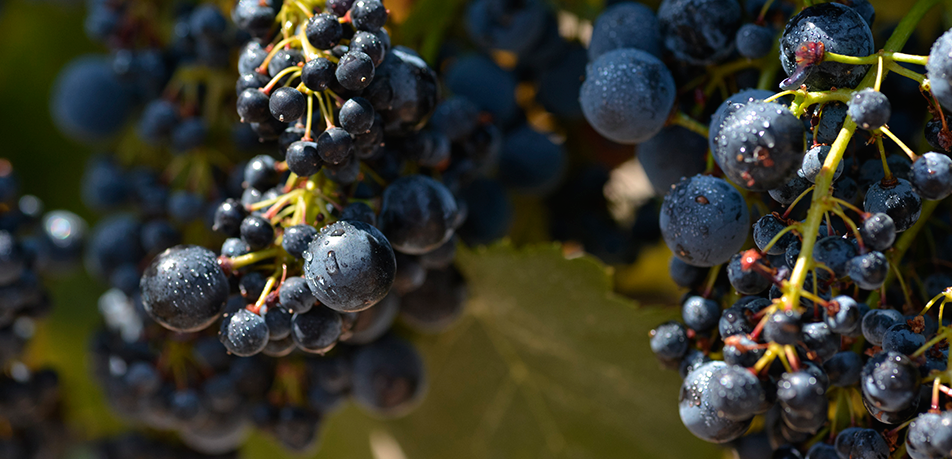ANCESTRAL VARIETIES

At the most recent edition of Alimentaria, Familia Torres's fifth generation, represented by Miguel and Mireia Torres, hosted an unprecedented tasting of ancestral variety wines.
[[{"fid":"17928","view_mode":"default","fields":{"format":"default","alignment":"","field_file_image_alt_text[und][0][value]":false,"field_file_image_title_text[und][0][value]":false},"type":"media","field_deltas":{"1":{"format":"default","alignment":"","field_file_image_alt_text[und][0][value]":false,"field_file_image_title_text[und][0][value]":false}},"link_text":null,"attributes":{"height":718,"width":977,"style":"height: 367px; width: 500px;","class":"media-element file-default","data-delta":"1"}}]]
Miguel and Mireia Torres during the ancestral varieties tasting at Alimentaria
These singular wines emphasize the identity and personality of the land that has witnessed their (re)birth. The varieties represent a cultural and winegrowing legacy that predates the tabula rasa of phylloxera.
Innovating to go back in time
It has been a paradoxical journey, from groundbreaking research to reviving a heritage both intimately ours and mostly forgotten. Innovating to go back in time, one could say. Every variety identified as ancestral undergoes a long process of sanitary verification and in vitro propagation, reproduction in the greenhouse, adaptation to the vineyard, microvinification to determine its potential and, finally, registration with the relevant authorities.
A thrilling process to bring back a past that we need now more than ever. It all springs from a romanticism and conviction rooted in knowledge. After all, there is plenty of poetry and idealism in a process that now, thirty years later, is starting to show tangible results.
By now almost fifty varieties have been recovered. Familia Torres decided to focus its efforts on five of them, chosen for their enormous enological potential and ability to adapt to the new challenges of climate change.
The varieties, the wines and...an announcement.
[[{"fid":"17929","view_mode":"default","fields":{"format":"default","alignment":"","field_file_image_alt_text[und][0][value]":false,"field_file_image_title_text[und][0][value]":false},"type":"media","field_deltas":{"2":{"format":"default","alignment":"","field_file_image_alt_text[und][0][value]":false,"field_file_image_title_text[und][0][value]":false}},"link_text":null,"attributes":{"height":669,"width":1140,"style":"height: 293px; width: 500px;","class":"media-element file-default","data-delta":"2"}}]]
Garden of varieties at the Mas Rabell estate (Penedès)
The five varieties that meet the criteria in terms of adaptability and enological potential are Forcada, Pirene, Gonfaus, Moneu and Querol. Discovered in different parts of Catalonia, they are now grown on an experimental basis in those Familia Torres vineyards that bring their full potential to expression.
Varieties of undeniable originality that do have certain characteristics in common:
Aromatic intensity, striking freshness and elegant liveliness. Endowed with excellent acidity, they are resistant to high temperatures and water stress.
- Moneu: In the 2017 vintage (its first), Moneu, an indigenous Penedès variety, presents an intense mix of black fruit, freshness, elegance and good acidity.
[[{"fid":"17930","view_mode":"default","fields":{"format":"default","alignment":"","field_file_image_alt_text[und][0][value]":false,"field_file_image_title_text[und][0][value]":false},"type":"media","field_deltas":{"3":{"format":"default","alignment":"","field_file_image_alt_text[und][0][value]":false,"field_file_image_title_text[und][0][value]":false}},"link_text":null,"attributes":{"height":611,"width":915,"style":"height: 334px; width: 500px;","class":"media-element file-default","data-delta":"3"}}]]
Cluster of Moneu grapes (grown in Penedès Central)
- Pirene and Gonfaus: Both originate from Costers del Segre, but are grown at different elevations. Pirene is becoming acclimatized to the Tremp vineyards, the highest in terms of elevation, which has resulted in a nose of great concentrated intensity, with rich fruit and subtle elegance. By contrast, Gonfaus is settling in at Les Garrigues, the driest vineyards. According to Mireia Torres, however, Gonfaus is “the most balanced variety of all the ones recovered so far. The wines are jammy, round, with excellent acidity.”
[[{"fid":"17935","view_mode":"default","fields":{"format":"default","alignment":"","field_file_image_alt_text[und][0][value]":false,"field_file_image_title_text[und][0][value]":false},"type":"media","field_deltas":{"8":{"format":"default","alignment":"","field_file_image_alt_text[und][0][value]":false,"field_file_image_title_text[und][0][value]":false}},"link_text":null,"attributes":{"height":409,"width":698,"style":"height: 293px; width: 500px;","class":"media-element file-default","data-delta":"8"}}]]
[[{"fid":"17936","view_mode":"default","fields":{"format":"default","alignment":"","field_file_image_alt_text[und][0][value]":false,"field_file_image_title_text[und][0][value]":false},"type":"media","field_deltas":{"9":{"format":"default","alignment":"","field_file_image_alt_text[und][0][value]":false,"field_file_image_title_text[und][0][value]":false}},"link_text":null,"attributes":{"height":414,"width":707,"style":"height: 293px; width: 500px;","class":"media-element file-default","data-delta":"9"}}]]
Clusters of Pirene and Gonfaus, both grown in the foothills of the Pyrenees
- Querol: Querol was one of the first ancestral varieties to be rescued from oblivion. It has gone on to join the blend of the prestigious Grans Muralles 2010. Querol is named after the village where it was found, on the Penedès county line. The variety has adjusted to its new home in the Muralles vineyard, in D.O. Conca de Barberà, and stands out for a particularly curious attribute. It is one of the few known female varieties, with extremely small berries that produce wines with “lots of fruit, a good midpalate, and soft, round tannins,” states Mireia.
[[{"fid":"17933","view_mode":"default","fields":{"format":"default","alignment":"","field_file_image_alt_text[und][0][value]":false,"field_file_image_title_text[und][0][value]":false},"type":"media","field_deltas":{"6":{"format":"default","alignment":"","field_file_image_alt_text[und][0][value]":false,"field_file_image_title_text[und][0][value]":false}},"link_text":null,"attributes":{"height":665,"width":996,"style":"height: 334px; width: 500px;","class":"media-element file-default","data-delta":"6"}}]]
Cluster of Querol grapes (grown in Conca de Barberà)
- Forcada: Our palates delighted in the only enologically significant white variety vinified so far. Grown in Alt Penedès, Forcada is very aromatic, with pronounced acidity that adds to its great aging potential. Its fresh flavor profile displays predominant citrus and white floral notes. The accompanying announcement might have been expected, but it still generated great excitement:
[[{"fid":"17934","view_mode":"default","fields":{"format":"default","alignment":"","field_file_image_alt_text[und][0][value]":false,"field_file_image_title_text[und][0][value]":false},"type":"media","field_deltas":{"7":{"format":"default","alignment":"","field_file_image_alt_text[und][0][value]":false,"field_file_image_title_text[und][0][value]":false}},"link_text":null,"attributes":{"height":588,"width":1003,"style":"height: 293px; width: 500px;","class":"media-element file-default","data-delta":"7"}}]]
Cluster of Forcada grapes (grown in Alt Penedès)
“Forcada 2015 will be the first varietal wine made from an ancestral variety to be brought to market. We’re looking at a very limited production to be released by the end of the year.” – Miguel Torres
Beyond the usual trappings of a tasting, what the project to revive ancestral varieties embodies, its realization and results, might add up to a turning point in the way viticulture is experienced and understood.
We need knowledge-based advances to recover a heritage that may be decisive to our future as winemakers and winegrowers. We see it as our duty to share our achievements—our methods and ideals—with all of the winery's collaborators who, in a secret corner of their vineyard parcels, have a forgotten and prized piece of our heritage waiting in the wings.
